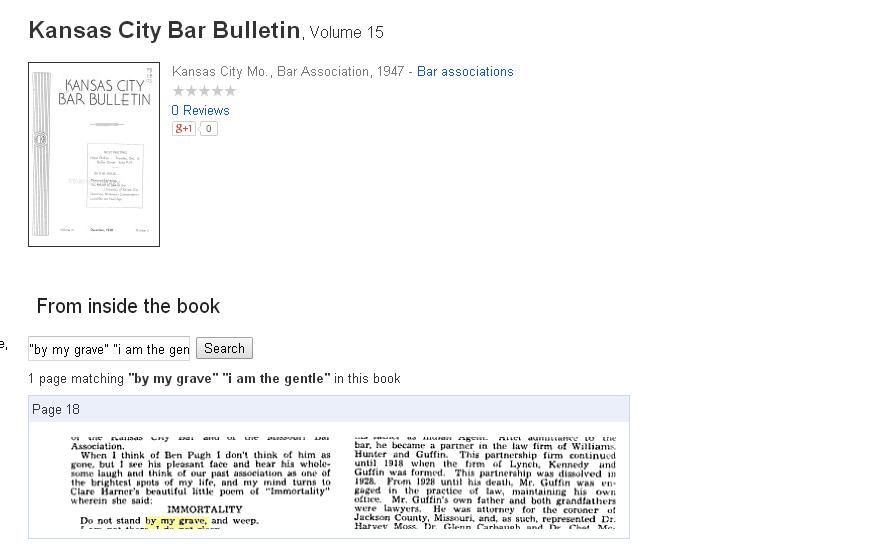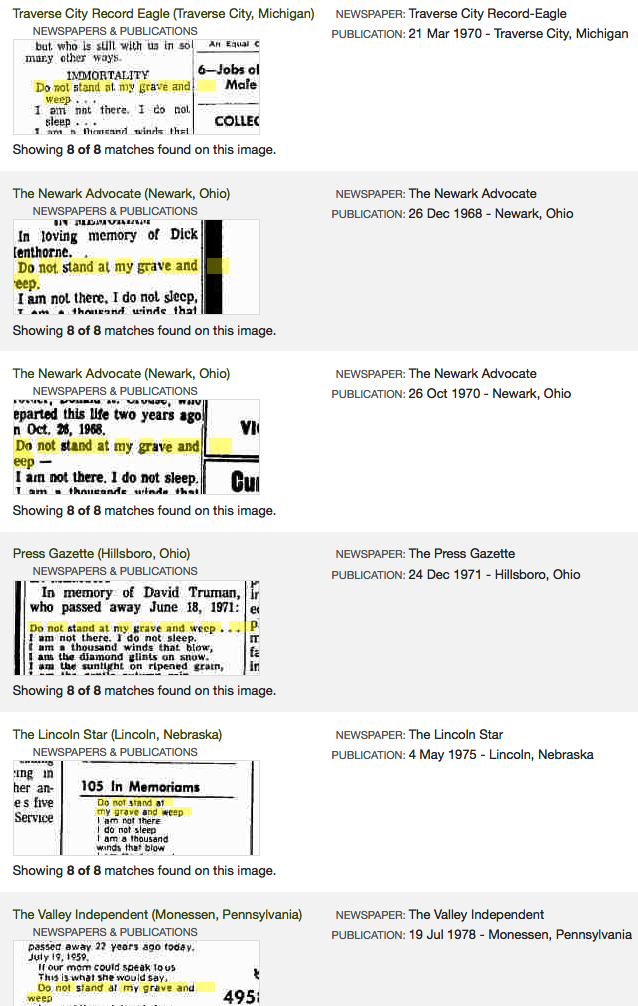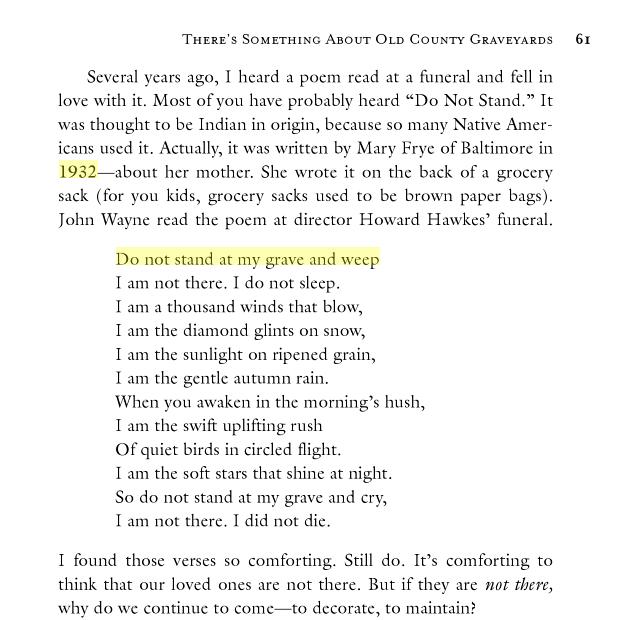Searching for the Author of ‘Do Not Stand at My Grave’ August 17, 2014
Author: Beach Combing | in : Contemporary , trackback‘Do not stand at my grave and weep’ is one of the most quoted twentieth-century poems in English. It is not Auden or Elliot or Ted Hughes or Geoffrey Hill. It is what Orwell called ‘good bad poety’: and Beach says this without any sense of judgement having listened obsessively to Abba all week. What is fascinating about the poem is that, even though (relatively) recent and much celebrated there is real doubt about who actually wrote it. The poem first became internationally famous in 1986 when ‘Dear Abby’ (Abigal van Buren) set out to look for its origins: it had been a eulogy for John Wayne, which had been read by Howard Hawks at Wayne’s funeral in 1979, by John Wayne at Howard Hawks funeral in 1977 (see comment below) and this might (???) explain why it was later claimed for an American Indian chief. It then reared up again on the death of a British soldier, Stephen Cummins, killed by an IRA road bomb in Northern Ireland in 1989. The poem had been scribbled out by SC in a letter to be left for his family in the case of his death. His father shared the poem with the national media and a mourning fiancé believed that Stephen himself had written it. (Stephen had actually signed the poem as ‘anonymous’). The poem regardless of its origin became an object of almost cult devotion in the UK. At this point the IRA stepped in and, not content with having killed the boy, also decided to detonate any shadow of a claim that the poem was by a Brit (it almost certainly wasn’t). They countered that it was, rather, by an American Republican supporter Marilyn Rhinehart (of Arizona) who had sent it to Terry Boyle, a Republican in Strablane prison. MR very probably did send such a poem. But she was not the author either. She had copied out an earlier version and had included Ireland in the last line ‘while Ireland lives I will not die!’ The present best claimant to the poem is, instead, one Mary Elizabeth Frye, a Baltimore woman (obit 2004): MEF, allegedly, wrote the poem, in 1932 to console a Jewish girl (Margaret Schwarzkopf) who had lost her mother in Germany, which has got it claimed, rather shakily, as a holocaust poem. Margaret regretted the fact that she had not been able to stand at her mother’s grave: and the poem certainly matches these circumstances. However, how good is the evidence? The earliest printed version dates back to 1938 and it was given no author: the page linked here offers the best history of the poem. The next printing that has been identified is in 1968 where it appears in the Portsmouth Herald (in a slightly different form) as an ‘in memoriam’ for a child. There is no contemporary evidence other than the late testimony of MEF that she wrote the poem, and there is her claim that almost immediately some printed copies were made and given to friends in a haphazard fashion, but these have never turned up. New evidence follows.
But before we get to the new evidence some fun. The original attempt to track down the poem was, as noted above, made by ‘Dear Abby’ in 1986. When she asked her readers, in her column syndicated around the English-speaking world, who had written the poem, many letters arrived. Here are a selection. ‘Dear Abby… May I modestly state that I am the author of the poem in question. I am 77 years old and have been a poet and journalist for the last 35 years. I wrote that poem in 1978 and titled it ‘Afterwards.’ John Wayne requested in his will that my poem be read at his graveside. I do hope that this will clear up the mystery of the origin of that poem. Neal S. Toomey, Lowell, Mass.’ ‘Dear Abby: The poem… was written by me in 1971 while on an extended holiday in America. I gave it to the president of the Reno Chamber of Commerce while visiting Nevada. That poem was tentatively named ‘A Clown’s Eulogy.’ [!!!!!] Needless to say, I am amazed that my work was used in the manner you have stated, and also very pleased that I have left something behind me besides bones. William Artus, Vancouver Island, British Columbia.’ ‘Dear Abby: In regards to the poem… The title is ‘I Am Not There,’ and I am the author. I composed the poem at Mr. Wayne’s request in 1977. Yours in life. Roberta Braun.’ ‘My grandmother wrote ‘Immortality’ and it was sent to all her grandchildren when Dad found it in the family Bible 10 years ago.’ Nor do the good times stop with Dear Abby. This is from a Wikipedia discussion page: ‘As to clear up all the encertainties about this poem: the writer could not be Mary E.Frye, as I [name deleted] wrote this poem on March 22nd, 1981. I still have my original handwritten copy in my possession. The first time I read my poem before an audiance was on November 2nd 1994, at the funeral of my father. In my family my grandfather alraedy wrote poetry and wrote music with his poetry… I am a Dutch woman, born on 29th of March 1944 in the Hague in the Netherlands/Europe. My poems are written in English as a result of my study in Eindhoven (NL) given by Cambridge University.’ And this one from 2008: ‘I’m 18 years old, living in Western New York. Growing up you hear stories about your parent’s past and their legacies, but one stood out to me from when I was little. I remember my mother talking about a poem that she wrote in high school, her grandfather had passed away and she went into a dark period where she locked herself away in her room and just listened to records and wrote, drew. One of the works that resulted from this week-long hide away is supposedly the poem ‘Do Not Stand At My Grave And Weep’ marked anonymous for fear that the dark subject would turn people off, make them think she was ‘weird’.’ Perhaps it is too easy to be cruel about these claimants (sincere, mad/delusional, forgetful or dishonest). Perhaps the only important truth is that we have a poem that belongs to ‘the people’. A simple rhyme structure that can be endlessly adapted for Indians, the Holocaust, grieving Brits, diehard Republicans… The best parallel is Lili Marlene from WW2…
Anyway, to the new evidence. At present there are three huge questions in trying to reconstruct the history of the poem. First is there any evidence from earlier than 1938: can we drag it back towards 1932 and Baltimore or even beyond? Second, what happened to the poem between 1938 and the next recorded printing in 1968 in the Portsmouth Herald? Third, what, if any, other poetic work inspired the poem? Beach can certainly push the poem back beyond 1968. In 1947 it appears in Kansas City Bar Bulletin vol. 15, p. 18. What is interesting about this version is that it is (a) titled and (b) given an author. It is called in fact ‘Immortality’ and ascribed to Clare Harner. Because of those bandits at Google I can only see a snippet so the page number may be out (see image above). But can someone please try and track down a full page copy so we can get this version up? It might be the key to confirming the authorship of the poem. When ‘Dear Abby’ researched the poem she had, as we have seen, a series of individuals writing in claiming the poem for themselves, but one of her correspondents wrote: ‘Dear Abby: I read in The Sacramento Bee that you are searching for the author of a poem recited as a eulogy for John Wayne. I have a tattered copy of that poem and the author is Clare Harner Lyon.’ Another wrote of CHL ‘She lived in Bakersfield, California. She died in 1971.’ That last quotation comes from a page where Abby was extremely sarcastic: will Abby (or at least the immortal part of her) have cause to regret it? Beach suspects not. The visible variant ‘Do not stand BY my grave’ is not in the 1938 version which has ‘AT’ my grave as do most versions today. Google gives some other results that are interesting. Google Books, in fact, seems to imply (without snippets) that the poem is in I Will Fight No More Forever: Chief Joseph and the Nez Perce War published University of Washington Press 1963 (hard as this is to believe). Could this be the origin of the idea that it is a poem by an Indian chief!? Google also spits up another book: Hazel Felleman, The Best Loved Poems of the American People (Doubleday 1936), but again no snippets. The metadata is correct (not always a given with those search engine shysters). Could anyone check this book for the poem (making sure it is the 1936 edition)? If it is there (never trust Google, never trust Google) it will amost certainly have an author. Finally, some thoughts on inspiration. There is a claim out there that the poem was inspired by Wordsworth’s ‘The Complaint of a Forsaken Indian Woman’ that seems a very weak parallel, at least to this blogger. However, there is another more intriguing suggestion that compares it to Graves’ translation of the Gaelic Song of Amergin (scroll down in link). ‘I am a wind of the sea, I am a wave of the sea…’ Graves was an appalling translator of the Celtic tongues, he had about forty Welsh words and knew how to use a dictionary. But there is also some middle Welsh poetry with a similar ‘I am’ structure and there is certainly something elemental in ‘Do not stand’: perhaps another way of saying that the author kept things simple? It is easy to see why someone tried to give it an American Indian background. It would have looked so good on a poster in a student’s dorm superimposed on a shot of the Grand Canyon and ascribed to Kicking Horse or some such.
Help with any of this? drbeachcombing AT yahoo DOT com
17 Aug 2014: Pausanias adds a series of negative results, but as he points out, ‘negative results should be mentioned as well.’ It will certainly save later diggers a lot of work. First he found the poem in a book from 1865. P. writes that the book ‘Mentions Thomas Holden, a Wooster descendent who died in 1995. so this is probably from his obituary, inserted into the copy of the book scanned by Google. The copy of the book on archive.org has no such text: I searched the kajillions of newspaper obituaries and grave inscriptions on ancestry.com.’ There P. found a series of cases from the late 60s and 1970s before an explosion in the 1980s. Thanks Pausanias!!!
18 Aug 2014: Jimbo writes in with a correction. John Wayne read the poem at Howard Hawks’ funeral not vice versa. I was going to contest this until I found that HH died in 1977 and JW in 1979. He also sends in this from extract from Untiedt Death Lore: Texas Rituals etc that alleges that the poem was written for Frye’s mother.
25 Mar 2016: Patty writes in ‘I am a librarian with the Buffalo & Erie Public Library system who received an inquiry as to the author of a poem he had entitled “Indigenous American Prayer” with essentially the same lines as “Do Not Stand at My Grave and Weep.” In the processing of researching the origin of the poem and its author, I came across your article. I wanted to let you know that our library has a copy (three, in fact) of “The Best Loved Poems of the American People”, the 1936 edition that you referenced in the article. The poem is not listed under any of the lines that I had for it from my inquiry, and definitely not with a first line of “Do Not Stand at My Grave and Weep.” Our library also owns a copy of “I Will Fight No More Forever: Chief Joseph and the Nez Perce War” by Merrill D. Beal, University of Washington Press, 1963, that you also mentioned in your article. I didn’t read it word for word, but didn’t notice any obvious mention of the poem in the book. I plan on a more thorough investigation as time permits, and if I do find something, I will let you know. Thank you very much for your article. It was one of the more comprehensive pieces that allowed me to answer my patron’s question.
Robin, 19 Jan 2017: Chief Joseph is a relative of mine, a lot of things he said were recorded. Nothing I’ve run across, like this particular poem. But a quote from another Indian chief, Chief Sealth, the namesake of the city of Seattle is close..In more of a “forget us at your peril” manner..this from a speech he gave in 1854. “When the last Red man shall have perished, and the memory of my tribe shall have become a myth among the White men, these shores will swarm with the invisible dead of my tribe, and when your children’s children think themselves alone in the field, the store, the shop, upon the highway, or in the silence of the pathless woods, they will not be alone. In all the earth there is no place dedicated to solitude. At night when the streets of your cities and villages are silent and you think them deserted, they will throng with the returning hosts that once filled them and still love this beautiful land. The White man will never be alone.” I think about this when I walk around a city in North America, late at night..A few times, I imagine, I’ve felt the echo of them.





